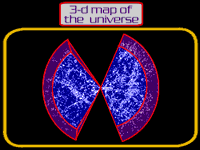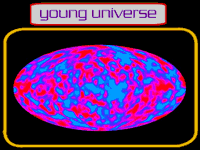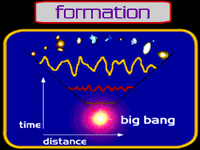- Objective:
To learn how the galaxies form.
- New Concept:
-
cold dark matter.

Fig. 1 Galaxy distribution in today's universe, 15 billion years after the Big Bang. Every dot is a galaxy. We are at the center. See the section Cluster, Supercluster and beyond for detail.
|
-
Today's universe is highly structured. Matter -- at least visible matter -- is concentrated in stars, galaxies and clusters of galaxies, and the remaning space is just empty, as shown in Fig 1.
However, when the universe was young, it was extremely uniform. Matter spread everywhere almost equally. At the age of 300,000 years, the mass density varied from place to place, but only by an amount of less than one part in 100,000
of the mean density, which is barely detectable by today's technology (see Fig 2). This uniformity is very impressive. Imagine a pond of one meter deep; this uniformity implies that the ripple can only deviate from the surface of the pond by
0.01 mm -- smaller than a single strand of hair.
Since our universe looks so different at different ages, a question naturally arises: how can the universe
evolve from incredibly uniform to highly structured? Or how does matter gather itself from uniformity to
form galaxies? The answer partly lies in gravity.
|

Fig. 2 The ripples of the universe at the age of 300,000 years, mapped by the COBE satellite.
This is actually a temperature map of the sky. Red areas are warmer than the mean temperature of 2.73 Kelvin, which in turn translates to a bit denser radiation and matter;
blue areas are cooler, or a bit less dense in radiation and matter. The average deviation from the mean
temperature is about 0.00001 Kelvin.
|
- Growth Mechanism
-
Gravity is an attractive force. So if some areas are a little denser in matter than others, no matter how small
the gathering is, the denser area will pull in surrounding matter and make itself more dense. This process
goes continuously and the tiny gathering in matter then increases until certain structures -- such as
galaxies and clusters of galaxies -- form.
This mechanism of formation is basically correct; however, it is not that simple. The problem is that (a) the
original gathering in matter must not be larger than 0.001 percent, and (b) our universe at present is not
older than 15 billion years. Within these two constraints, there is simply no time for the small gathering in
matter to grow into the structures we have observed today. Gravity alone, therefore, does not explain it;
there must be a missing ingredient.
|

Fig.3 A sketch of how the galaxies form. It starts with a tiny ripple in the matter density at about 300,000 years after the Big Bang. The fluctuation then grows up under the influence of gravity and a few billion years later the galaxies appear.
Figure Credits:
Fig.1 Harvard Smithsonian Center for Astrophysics.
Fig.2 NASA, COBE.
Fig.3 Z. H. Zhou
|
- Cold Dark Matter-- the missing ingredient?
-
To attack the problem, many cosmologists have turned to the dark matter. They believe if the dark matter
is made up of exotic particles that are neither protons nor neutrons but much heavier than them, then at the
time the universe was 300,000 years old, the gathering in exotic matter could be higher than 0.001 per cent
of the mean density. This kind of heavy exotic matter is referred to as Cold Dark Matter, or CDM for short.
With higher initial rippling in CDM, the tiny gathering in ordinary matter could grow more quickly. Hence 15
billion years may have been long enough for the structures to form.
The CDM scenario has achieved great success in explaining galaxy formation; in fact, it has been the most popular model. However, detailed study has revealed that the model suffers several serious drawbacks; for instance, it can explain galaxy distributions on either large scale (hundreds of millions of light years) or small scale (several millions of light years) but not on both. It is now widely believed that the CDM model also fails to work on its own. So the question of galaxy formation is still an open one.
It may be the biggest challenge faced by cosmologists today.
|

